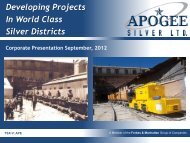Pulacayo Project Feasibility Study - Apogee Silver
Pulacayo Project Feasibility Study - Apogee Silver
Pulacayo Project Feasibility Study - Apogee Silver
You also want an ePaper? Increase the reach of your titles
YUMPU automatically turns print PDFs into web optimized ePapers that Google loves.
<strong>Pulacayo</strong> 1 000 t/d Phase I <strong>Feasibility</strong> <strong>Study</strong> - NI 43-101 Technical Report<br />
090644-3-0000-20-IFI-100<br />
14 MINERAL RESOURCE ESTIMATE<br />
14.1 General<br />
The definition of mineral resource and associated mineral resource categories used in this<br />
report are those recognized under National Instrument 43-101 and set out in the Canadian<br />
Institute of Mining, Metallurgy and Petroleum Standards on Mineral Resources and Reserves<br />
Definitions and Guidelines (the CIM Standards). Assumptions, metal threshold parameters<br />
and deposit modeling methodologies associated with the current <strong>Pulacayo</strong> resource estimate<br />
are discussed.<br />
14.2 Geological Interpretation Used In Resource Estimation<br />
The <strong>Pulacayo</strong> deposit is considered a low sulphidation epithermal deposit hosting both<br />
precious and base metals, of which silver, lead and zinc are of economic significance.<br />
Mineralization included in the current resource is associated with the TVS that were<br />
emplaced on the southern side of the <strong>Pulacayo</strong> dome complex that contains Tertiary<br />
sediments of the Quenhua Formation and Miocene intrusive andesitic volcanic rocks of the<br />
Rothchild and Megacristal units. The dome complex is tens of km in length and commonly<br />
hosts polymetallic sulphide mineralization within east-west trending fault systems. The TVS is<br />
the most prominent mineralized structure on the property and portions of the trend have been<br />
mined for several hundred years. The structure strikes east-west and has near vertical dip in<br />
most areas.<br />
TVS mineralization is hosted by both volcanic and sedimentary host rocks, with stock works<br />
of narrow veins and veinlets plus disseminations that aggregate up to 120 m in width being<br />
typical of volcanic hosted sections. Sections hosted by sedimentary rocks show much<br />
narrower high grade vein structures that typically measure a few meters or less in width.<br />
These generally bifurcate transitionally upward into the stock work style systems and zones<br />
of dissemination seen in the overlying volcanic rocks.<br />
Mineralization is known to extend along the TVS strike for 2,700 m and to a depth of almost<br />
1,000 m below surface. The latter reflects the depth of historic mining, of which approximately<br />
450 m occur within overlying volcanic host rocks and 550 m occur within the sedimentary<br />
sequence. The portion of the TVS defined by <strong>Apogee</strong> drilling and considered in this resource<br />
estimate extends along strike for approximately 1,500 m and to an average depth of 450 m<br />
below surface. As a result, most of the resource area is hosted by andesitic volcanic<br />
lithologies.<br />
Contributing minerals of economic significance include galena, sphalerite, tetrahedrite and<br />
other silver sulfosalts, along with minor occurrences of chalcopyrite and jamesonite. These<br />
minerals are accompanied by barite, quartz, pyrite, and calcite. Local occurrences of Au have<br />
also been noted but not extensively assessed to date. Veins generally have a banded<br />
texture, with segments containing semi-massive to massive sulphides. The TVS shows<br />
vertical metal zonation with increasing base metal concentrations with depth and higher Ag<br />
content at middle elevations (350 m to 450 m depth).<br />
TWP Sudamérica S.A. Av. Encalada 1257 Of. 801, Santiago de Surco Lima 33, Perú (51-1) 4377473<br />
Page 112



